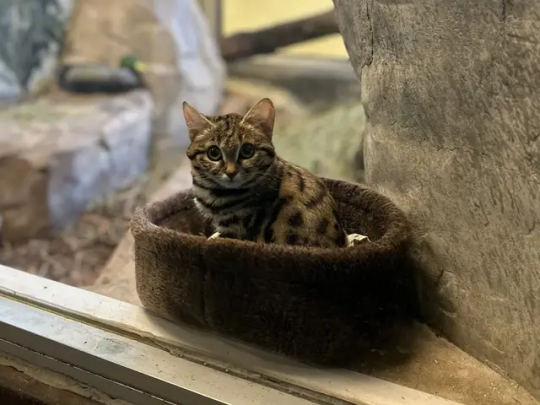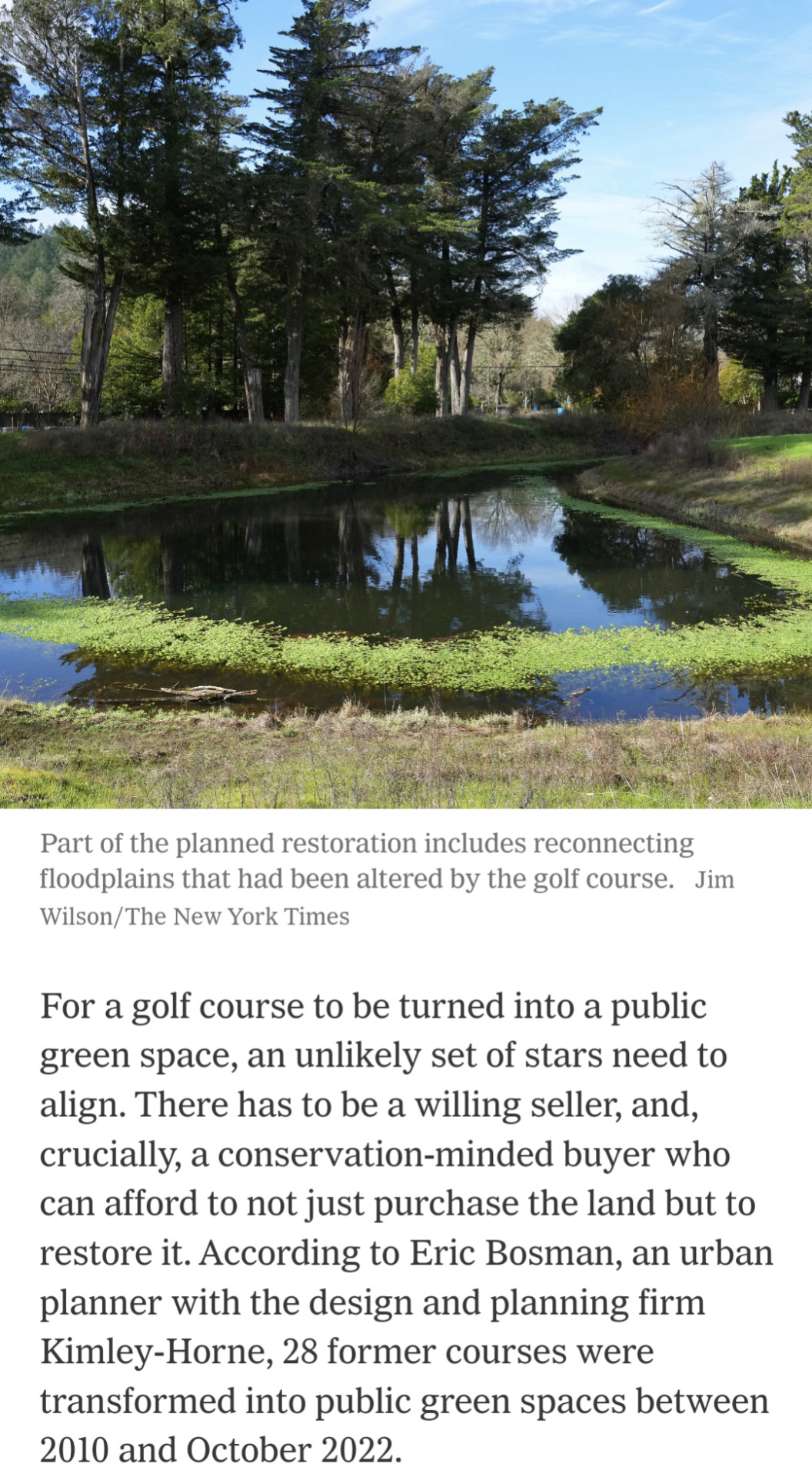#conservation news
Text
Im fucking sobbing looking at the new black footed cat at Utah's Hogle zoo
Shes just a fucking baby


Baby with a 60% successful kill rate
#wrenfea.article#theres a video in the article#her name is gaia and shes 8 months#shes part of the AZA breeding program#i now have a reason to visit utah#leetle baby gorl#black footed cat#conservation news#conservation#zoos#animals#also the highest successful kill percentage for big cats is like. 25%#so 60% is fucking crazy
50K notes
·
View notes
Text
"A century of gradual reforestation across the American East and Southeast has kept the region cooler than it otherwise would have become, a new study shows.
The pioneering study of progress shows how the last 25 years of accelerated reforestation around the world might significantly pay off in the second half of the 21st century.
Using a variety of calculative methods and estimations based on satellite and temperature data from weather stations, the authors determined that forests in the eastern United States cool the land surface by 1.8 – 3.6°F annually compared to nearby grasslands and croplands, with the strongest effect seen in summer, when cooling amounts to 3.6 – 9°F.
The younger the forest, the more this cooling effect was detected, with forest trees between 20 and 40 years old offering the coolest temperatures underneath.
“The reforestation has been remarkable and we have shown this has translated into the surrounding air temperature,” Mallory Barnes, an environmental scientist at Indiana University who led the research, told The Guardian.
“Moving forward, we need to think about tree planting not just as a way to absorb carbon dioxide but also the cooling effects in adapting for climate change, to help cities be resilient against these very hot temperatures.”
The cooling of the land surface affected the air near ground level as well, with a stepwise reduction in heat linked to reductions in near-surface air temps.
“Analyses of historical land cover and air temperature trends showed that the cooling benefits of reforestation extend across the landscape,” the authors write. “Locations surrounded by reforestation were up to 1.8°F cooler than neighboring locations that did not undergo land cover change, and areas dominated by regrowing forests were associated with cooling temperature trends in much of the Eastern United States.”
By the 1930s, forest cover loss in the eastern states like the Carolinas and Mississippi had stopped, as the descendants of European settlers moved in greater and greater numbers into cities and marginal agricultural land was abandoned.
The Civilian Conservation Corps undertook large replanting efforts of forests that had been cleared, and this is believed to be what is causing the lower average temperatures observed in the study data.
However, the authors note that other causes, like more sophisticated crop irrigation and increases in airborne pollutants that block incoming sunlight, may have also contributed to the lowering of temperatures over time. They also note that tree planting might not always produce this effect, such as in the boreal zone where increases in trees are linked with increases in humidity that way raise average temperatures."
-via Good News Network, February 20, 2024
#trees#forests#reforestation#tree planting#global warming#climate change#climate crisis#american south#the south#eastern us#southern usa#conservation#meteorology#global temperature#conservation news#climate news#environment#hope#good news#hope posting#climate action#climate science#climate catastrophe#climate hope
12K notes
·
View notes
Text
For the first time in its history, Aquarium of the Pacific has paired a releasable rescued sea otter pup with a surrogate otter mom.
“We are thrilled to be able to further help this threatened species recover by expanding our conservation programs to now help stranded sea otter pups get a second chance at returning to the wild,” says Brett Long, Aquarium of the Pacific senior director of birds and mammals.
Read more:
#sea otter surrogacy#sea otters#sea otter conservation#conservation news#aquarium of the pacific#otter#otters
283 notes
·
View notes
Link
“How do you supercharge vegetation growth for a reforestation project? Bring in the microorganisms.
That’s the finding from a new study, which shows that incorporating a microbial community of fungi, bacteria, algae and archaea into ecosystem restoration can accelerate plant biomass production by 64% on average.
Researchers say this application holds plenty of promise for restoration work in Southeast Asia, where large swaths of once-forested landscapes have been degraded for large-scale agriculture.
Soil microbiome like fungi carry out a critical task known as soil transplant, moving soil and associated microbial communities from one location to another. But they’re often overlooked in conservation and restoration efforts, said study lead author Colin Averill, a senior microbial and ecosystem scientist at the Swiss Federal Institute of Technology, or ETH Zürich.
“When we think to plant a tree, we never think to ‘plant’ the microbiome, right? But what if we did?” Averill told Mongabay.
To find out how big a role the microbiome plays in ecosystem restoration, Averill and colleagues from ETH Zürich, the Czech Academy of Sciences in Prague and Vrije Universiteit in the Netherlands pored over the date from 27 restoration projects that incorporated microbial restoration.
Their study, published in the journal Nature Microbiology, found that across all the restoration works, there was an average of 64% increase of plant growth. In one case, plant growth was stimulated by 700%.
The study shows that incorporating the microbiome in managed landscapes like farmland and forestry concessions has the greatest potential. This is because managed landscapes account for the majority of human land use, covering half of the global habitable land surface.
But by introducing microbial communities, these agricultural and forestry plantations [and monocultures] that are currently devoid of biodiversity could become reservoirs of it, Averill said.
To increase biodiversity and enrich these managed landscapes, it’s important to avoid using single species or very low-diversity, non-native soil organisms at a large scale, Averill said.
The study notes an increasing number of microbial inoculant companies advocating for just this on the argument that it could improve crop yields. But the mass application of a single species could lead to a loss of genetic and ecological diversity, and is unlikely to account for ecosystem-specific requirements, the study says.
It instead recommends using locally sourced, native and biodiverse communities of soil organisms as these can promote biodiversity in managed landscapes without limiting crop yields.” -via Mongabay, 1/5/23
#mongabay#mongabay environmental news#environmental news#conservation news#fungi#microbiome#monoculture#agriculture#reforestation#forest restoration#southeast asia#good news#hope#microorganisms
177 notes
·
View notes
Text

https://www.hawaii.edu/news/2023/05/21/ai-reef-conservation-tool/
Hot Conservation News!
Just over a week ago, the UoH created a new AI tool to aid in coral reef identification! This will allow researchers to cover a much wider area far quicker, and also allow them to study reef areas without risking damage to particularly sensitive reefs.
15 notes
·
View notes
Text




#palestine#israel#journalism#news#gaza strip#gaza#palestinians#democrats#republicans#woc#muslims#islam#human rights#conservatives#us politics
61K notes
·
View notes
Text
Extremely dangerous how "grooming" in the context of child sexual abuse went from being a very specific pattern of isolation and trust-building with the aim of abusing someone to "telling children anything that contradicts their parents' ultra-conservative worldview is grooming" to "selling rainbow flags in a store is grooming" to "literally anyone I don't like is a groomer".
These days the word seems to most often be used by people who don't care about what it actually means and just want an easy "this person is irredeemably evil, kill them now" button.
#conservatives accusing people they don't like of being child abusers is not new to be clear#I'm just talking about how they're making this term much less useful by damaging its definition#100#1k#2k#3k#4k#5k#10k#15k#20k#25k#30k#40k
41K notes
·
View notes
Text
How Communities in Africa are Fighting Against Carbon Colonialism
In an alarming development across Africa, Indigenous communities are rising against the trend of ‘carbon colonialism‘—a term activists use to describe the problematic carbon credit schemes that threaten their way of life. At the heart of this contention is the clash between Conservation efforts aimed at combatting Climate change and the basic human rights of local populations, whose livelihoods…

View On WordPress
#animal conservation#animal rescues#conscious consumerism#conscious consumers#conservation news#cruelty free#eco friendly lifestyle#eco friendly pet products#eco-friendly fashion#ecofriendly shopping#environmental news#gluten free recipes#GMO FREE#go green#green fashion#green living#green news#green tips#plant based health#plant based lifestyle.#plant based recipes#raw lifestyle#raw vegan recipes#recycling#social justice#Sustainability#vegan desserts#vegan diet#vegan fashion#vegan health
0 notes
Text
New Petitions to Sign This Week: Help Shut Down Dog Fighting Rings in Connecticut, Justice for Dogs Who Were Starved and Abused, Help Ban Exotic Skins and Feathers, and More!
New Post has been published on https://petn.ws/3Ko2V
New Petitions to Sign This Week: Help Shut Down Dog Fighting Rings in Connecticut, Justice for Dogs Who Were Starved and Abused, Help Ban Exotic Skins and Feathers, and More!
Unfortunately, the world is not a very peaceful or safe place for many individuals. From conflict to abuse to exploitation, there is so much cruelty inflicted on both humans and animals. While this can get disheartening and difficult to hear, petitions are a great way to use your voice for good. Just by signing one, […]
See full article at https://petn.ws/3Ko2V
#DogNews #AnimalConservation, #AnimalRescues, #ConsciousConsumerism, #ConsciousConsumers, #ConservationNews, #CrueltyFree, #EcoFriendlyLifestyle, #EcoFriendlyPetProducts, #EcoFriendlyFashion, #EcofriendlyShopping, #EnvironmentalNews, #GlutenFreeRecipes, #GMOFREE, #GoGreen, #GreenFashion, #GreenLiving, #GreenNews, #GreenTips, #PlantBasedHealth, #PlantBasedLifestyle, #PlantBasedRecipes, #RawLifestyle, #RawVeganRecipes, #Recycling, #SocialJustice, #Sustainability, #VeganDesserts, #VeganDiet, #VeganFashion, #VeganHealth, #VeganMeals, #VeganProducts, #VeganProteinPowders, #VeganRecipesVeganFood, #VeganSupplements, #Veganism, #VegetarianFood
#animal conservation#animal rescues#conscious consumerism#conscious consumers#conservation news#cruelty free#eco friendly lifestyle#eco friendly pet products#eco-friendly fashion#ecofriendly shopping#environmental news#gluten free recipes#GMO FREE#go green#green fashion#green living#green news#green tips#plant based health#plant based lifestyle.#plant based recipes#raw lifestyle#raw vegan recipes#recycling#social justice#sustainability#vegan desserts#vegan diet#vegan fashion#vegan health
0 notes
Text
"When considering the great victories of America’s conservationists, we tend to think of the sights and landscapes emblematic of the West, but there’s also a rich history of acknowledging the value of the wetlands of America’s south.
These include such vibrant ecosystems as the Everglades, the Great Dismal Swamp, the floodplains of the Congaree River, and “America’s Amazon” also known as the “Land Between the Rivers”—recently preserved forever thanks to generous donors and work by the Nature Conservancy (TNC).
With what the TNC described as an “unprecedented gift,” 8,000 acres of pristine wetlands where the Alabama and Tombigbee Rivers join, known as the Mobile Delta, were purchased for the purpose of conservation for $15 million. The owners chose to sell to TNC rather than to the timber industry which planned to log in the location.
“This is one of the most important conservation victories that we’ve ever been a part of,” said Mitch Reid, state director for The Nature Conservancy in Alabama.
The area is filled with oxbow lakes, creeks, and swamps alongside the rivers, and they’re home to so many species that it ranks as one of the most biodiverse ecosystems on Earth, such that Reid often jokes that while it has rightfully earned the moniker “America’s Amazon” the Amazon should seriously consider using the moniker “South America’s Mobile.”
“This tract represents the largest remaining block of land that we can protect in the Mobile-Tensaw Delta. First and foremost, TNC is doing this work for our fellow Alabamians who rightly pride themselves on their relationship with the outdoors,” said Reid, who told Advance Local that it can connect with other protected lands to the north, in an area called the Red Hills.
“Conservation lands in the Delta positions it as an anchor in a corridor of protected lands stretching from the Gulf of Mexico to the Appalachian Mountains and has long been a priority in TNC’s ongoing efforts to establish resilient and connected landscapes across the region.”
At the moment, no management plan has been sketched out, but TNC believes it must allow the public to use it for recreation as much as possible.
The money for the purchase was provided by a government grant and a generous, anonymous donor, along with $5.2 million from the Holdfast Collective—the conservation funding body of Patagonia outfitters."
youtube
Video via Mobile Bay National Estuary Program, August 7, 2020
Article via Good News Network, February 14, 2024
#united states#alabama#estuary#wetlands#swamp#river#environment#environmental issues#conservation#video#biodiversity#american south#ecosystems#ecology#conservation news#wildlife conservation#ecosystem#conservation efforts#good news#hope#forest#swampco#re#Youtube
2K notes
·
View notes
Text


The Aquarium of the Pacific is embarking on a new scientific project to help bull kelp, which has been in decline mainly due to warming waters associated with climate change and disruptions to the ocean food web. In Northern California, bull kelp has declined by 95 percent since 2008.
Kelp forests provide critically vital habitats for marine animals. Humans around the world also benefit from healthy kelp forests because they are an important source of oxygen and provide coastlines with physical protection from waves. The project is focused on preserving genetic diversity of bull kelp to help facilitate future kelp forest restoration projects. Aquarium animal husbandry staff are carefully preserving 1400 gametophytes or genetic material of bull kelp. These gametophytes will be stored in stasis at the Aquarium of the Pacific and can be used to grow kelp for outplanting it in the ocean to help restore kelp forest ecosystems.
The preservation technique is similar to what seed banks accomplish for plants. The biggest difference is that kelp use spores to disperse; these will settle and germinate into male and female microscopic gametophytes that will reproduce. By putting the gametophytes into stasis, the cell growth is hugely decreased keeping the bull kelp in microstages.
“In the event that wild kelp populations suffer catastrophic loss of genetic diversity, these gametophytes could be used to produce new kelp to restore local ecosystems. They can also be selectively bred to develop kelp that is more resistant to warmer temperatures,” says Jenn Anstey, Aquarium of the Pacific assistant curator.
This kelp conservation project is a partnership of the Aquarium of the Pacific, the University of Wisconsin at Milwaukee and California Sea Grant.
The western North American coastline is one of the areas where kelp grows. The rise of sea temperatures, the over-predation of kelp from purple sea urchins, and the loss of urchin eating sunflower sea stars have caused a major decline in kelp forests in the northern Pacific Ocean.
Bull kelp bed photo source: iStock
124 notes
·
View notes
Text

Siglo The group is the best Conservation Planning firm in Austin. Our team's deep understanding of Austin's unique ecosystem and regulatory landscape allows us to develop tailored strategies that maximize conservation impact while promoting economic growth. Join us in our mission to create a greener, more sustainable future for Austin and beyond.
0 notes
Text
Golf Courses ARE Being Converted
The Solarpunk "fantasy" that so many of us tout as a dream vision, converting golf courses into ecological wonderlands, is being implemented across the USA according to this NYT article!
The article covers courses in Michigan, Pennsylvania, California, Colorado, and New York that are being bought and turned into habitat and hiking trails.

The article goes more into detail about how sand traps are being turned into sand boxes for kids, endangered local species are being planted, rocks for owl habitat are being installed, and that as these courses become wilder, they are creating more areas for biodiversity to thrive.
Most of the courses in transition are being bought by Local Land Trusts. Apparently the supply of golf courses in the USA is way over the demand, and many have been shut down since the early 2000s. While many are bought up and paved over, land Trusts have been able to buy several and turn them into what the communities want: public areas for people and wildlife. It does make a point to say that not every hold course location lends itself well to habitat for animals (but that doesn't mean it wouldn't make great housing!)

So lets be excited by the fact that people we don't even know about are working on the solutions we love to see! Turning a private space that needs thousands of gallons of water and fertilizer into an ecologically oriented public space is the future I want to see! I can say when I used to work in water conservation, we were getting a lot of clients that were golf courses that were interested in cutting their resource input, and they ended up planting a lot of natives! So even the golf courses that still operate could be making an effort.
So what I'd encourage you to do is see if there's any land or community trusts in your area, and see if you can get involved! Maybe even look into how to start one in your community! Through land trusts it's not always golf course conversions, but community gardens, solar fields, disaster adaptation, or low cost housing! (Here's a link to the first locator I found, but that doesn't mean if something isn't on here it doesn't exist in your area, do some digging!)
#solarpunk#sustainability#climate change#gardening#activism#hope#climate justice#news#new york times#golf courses#habitat#conservation
14K notes
·
View notes
Link
0 notes
Text


This sounds like something from The Handmaid’s Tale, ffs.
#News#texas#politics#the handmaid’s tale#tht#tw miscarriage#reproductive rights#linkedin#conservatives#democrats#republicans#donald trump#healthcare
26K notes
·
View notes